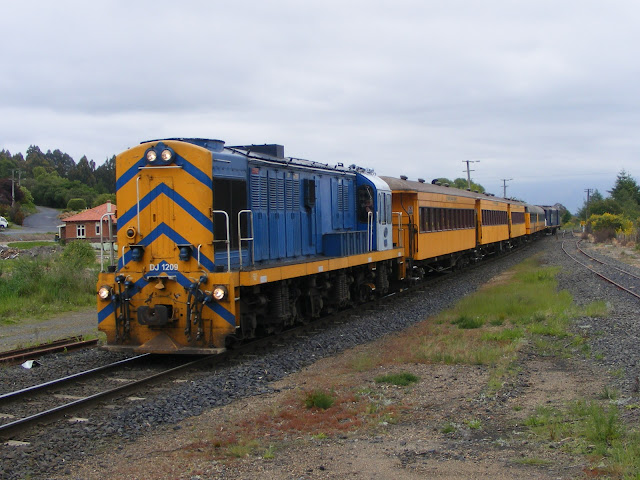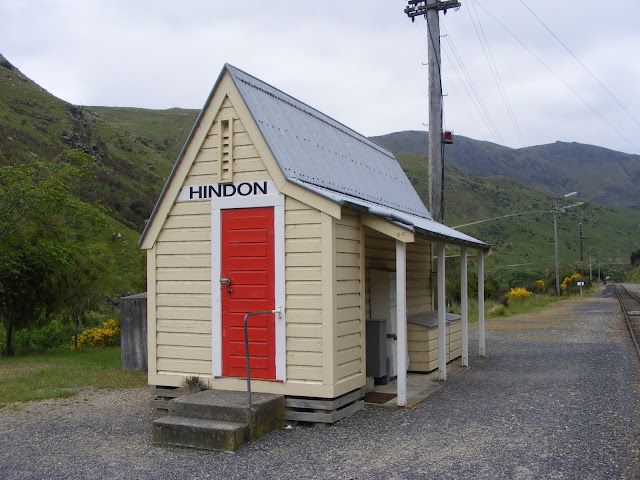Hindon Station Sign
After getting a few things done around Dunedin I had a few hours to spare before having to get home. With the camera in the car I thought I'd head out to one of my favourite spots, Wingatui Railway Station. Wingatui is the junction between the South Island Main Trunk and the former Otago Central Railway.
When the OCR closed in 1990, the Dunedin City Council purchased the picturesque portion of the line between Taieri and Middlemarch. The line was then run as a tourist line by the Otago Excursion Train Trust.
When the OCR closed in 1990, the Dunedin City Council purchased the picturesque portion of the line between Taieri and Middlemarch. The line was then run as a tourist line by the Otago Excursion Train Trust.
I didn't have to wait long before a Dunedin Railways passenger service came off the junction onto the South Island Main Trunk as it made its way back to Dunedin. Just a shame the DJ loco was running long hood first.
DJ 1209 arrives at Wingatui Railway Station with a Dunedin Railways passenger train. 15/11/17.
With the DJ and its train now gone I made my way to the Fonterra Siding at Taieri. Fonterra has a large store here which is mainly used to store milk powder from the dairy factory at Edendale. The milk powder is transferred from curtain sider containers into the store and then into standard 40 and 20 foot containers for export. Kiwi Rail run a number of Fonterra shunting services between Taieri, Dunedin and Port of Otago at Port Chalmers every day. During the dairy season the amount of milk powder being transported is so large that the line between Wingatui and Port Chalmers becomes one of the busiest single lines in New Zealand.
DC 4012 and DCP 4513 shunt a short container train into the Fonterra container sidings at Taieri. 15/11/17.
After getting a few shots at Taieri and with plenty of time to spare I decided to head up to Hindon. Hindon is a small station located in the Taieri Gorge. While there's no longer any freight trains using the line, Dunedin Railways, formally the Otago Excursion Train Trust and Taieri Gorge Railway, run regular passenger services from Dunedin through the Taieri Gorge to Pukerangi and Middlemarch.
Approaching Hindon I spotted a Dunedin Railways Hi-railer at work on the line. The line passes through some very rugged country and is very prone to slips and washouts. In fact, the Taieri Gorge line was closed between July and September this year after a storm caused washouts and slips along the line. Two Otago Daily Times stories about the storm damage can be found here and here.
A Dunedin Railways HI-Railer at work in the Taieri Gorge.
A crib (holiday house) above Hindon station has the old station sign attached.
Holiday house with the old Hindon station sign.
Before heading down to Hindon station I checked out the nearby Hindon road / rail bridge over the Taieri River. This bridge hasn't always been a road / rail bridge. Timber decking was added to the original bridge structure to allow road access to the north side of the Taieri River.
Approach to the Hindon road / rail bridge. 15/11/17.
The bridge is an awesome example of Victorian engineering. The lattice steel trusses and stone pillars have stood the test of time. Due to the isolated nature of the Taieri Gorge, engineers had to use building materials that were close at hand. Many of the bridges are constructed using stone pillars and abutments. Mortar holding the stone together was made using sand and aggregate from the river. Other construction materials like steel were hauled into the gorge using horses and bullock teams.
The Hindon road / rail bridge. 15/11/17.
From the road on the opposite side of the gorge I got my first sight of the Hindon railway station and yard.
Hindon Railway Station and Yard in the Taieri Gorge. 15/11/17.
Hindon itself was a small settlement established to serve farms in the area. Opened in 1889, Hindon railway station provided an important link between these isolated farms and the city of Dunedin. The station was used to cross trains making their way through the Taieri Gorge and provided a means for local farmers to receive goods and fertiliser and ship livestock and wool to freezing works and wool stores in Dunedin. Hindon was also an important passenger stop as it had a refreshment room for passengers heading between Dunedin and Central Otago.
Today Hindon is a stopping point for Dunedin Railway passenger trains and is also used to store Dunedin Railways maintenance train.
Hindon station and yard with the maintenance train. 15/11/17.
Hindon Railway Station.15/11/17.
Rear of the station.
Side of the station.
Station front.
The station yard still has a lot of infrastructure that could be found at yards throughout New Zealand from the 1950's through to the 1980's.
Jigger and maintenance of way sheds.
Main line points lever.
Hindon station yard. 15/11/17.
In the yard was Dunedin Railway's maintenance train consisting of bogie flat wagons, four wheel ballast wagons and a ballast plow van.
Dunedin Railway's maintenance train at Hindon. 15/11/17.
Bogie Flat Wagon US90 at Hindon. 15/11/17.
Ballast wagon YC 648 at Hindon. 15/11/17.
Ballast plow van EP65 at Hindon. 15/11/17.
After getting some shots around Hindon it was time to head back to Dunedin. As I climbed out of the gorge I stopped to get a shot of the Christmas Creek Bridge, one of several curved lattice steel bridges found in the Taieri Gorge.
Christmas Creek Bridge. 15/11/17.
As I got back into the car I heard the unmistakable noise of a DJ's Caterpillar D398 V12 diesel engine approach. After a short run down the road I was able to grab a few shots of a Dunedin Railways service as it crossed the Christmas Creek and Hindon bridges on its approach to Hindon.
A Dunedin Railways passenger train crosses Christmas Creek in the Taieri Gorge. 15/11/17.
A Dunedin Railways passenger train crosses over the Taieri River near Hindon. 15/11/17.
A Dunedin Railways passenger train rounds some curves as it approaches Hindon station. 15/11/17.
With time ticking it was time to end my adventure and head back to town.
If you're around Dunedin and get the chance, I can't recommend a trip on Dunedin Railways through the Taieri Gorge enough. The Dunedin Railways staff do an amazing job maintaining and operating this beautiful piece of railway line.
For more information about Dunedin Railways and their passenger services go to their website at www.dunedinrailways.co.nz .
And that's about it.






































